Strategic Operations Management: IKEA's Strategy, Value Chain Analysis
VerifiedAdded on 2023/04/08
|10
|2129
|119
Report
AI Summary
This report provides an overview of IKEA's operations management, analyzing its operational and organizational strategies, order winners and qualifiers, and value chain. It discusses IKEA's performance objectives, including quality, speed, dependability, and flexibility, and how these contribute to its competitive advantage. The report also examines IKEA's value chain, focusing on inbound logistics, operations, outbound logistics, marketing and sales, and services. It highlights IKEA's global sourcing strategy, decentralized business approach, and Do-It-Yourself concept. Furthermore, the report offers recommendations for improvement, such as implementing Quality Function Deployment (QFD) and Design for Manufacture (DFM) to enhance product quality and reduce costs. The analysis concludes that while IKEA excels in retail, it should focus on strengthening its manufacturing processes to maintain a competitive edge. This assignment solution is available on Desklib, a platform offering a wealth of academic resources for students.
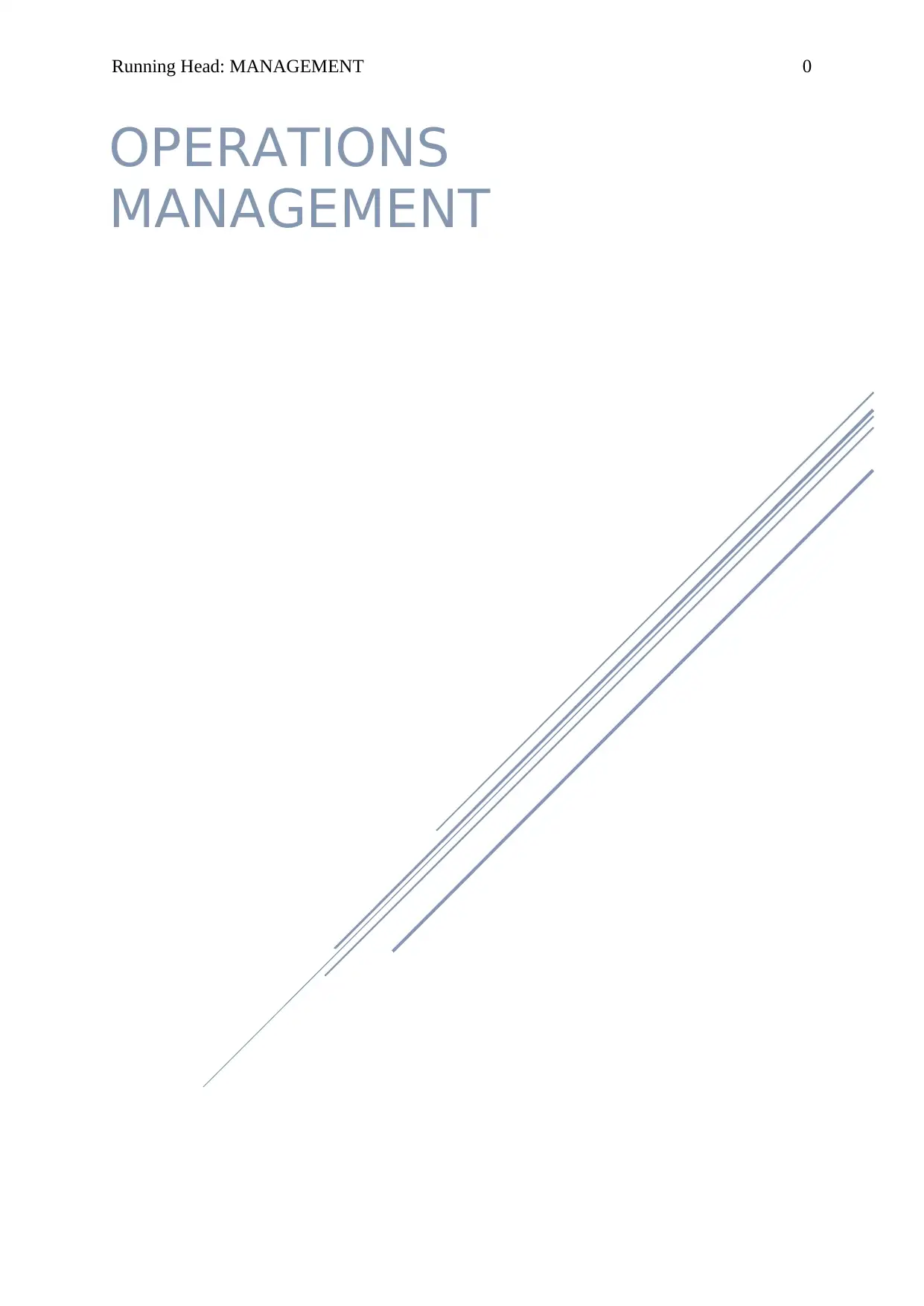
Running Head: MANAGEMENT 0
OPERATIONS
MANAGEMENT
OPERATIONS
MANAGEMENT
Paraphrase This Document
Need a fresh take? Get an instant paraphrase of this document with our AI Paraphraser
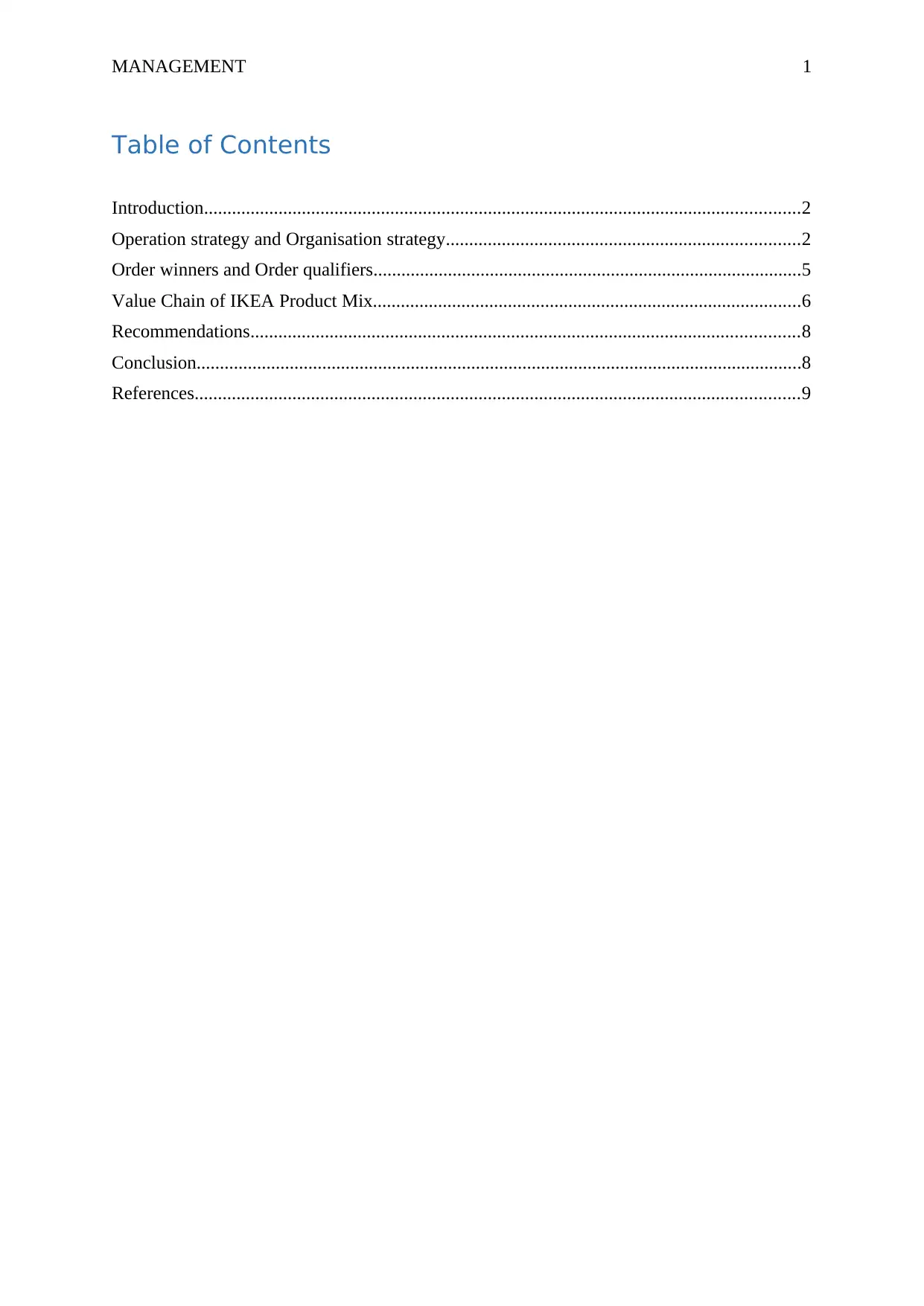
MANAGEMENT 1
Table of Contents
Introduction................................................................................................................................2
Operation strategy and Organisation strategy............................................................................2
Order winners and Order qualifiers............................................................................................5
Value Chain of IKEA Product Mix............................................................................................6
Recommendations......................................................................................................................8
Conclusion..................................................................................................................................8
References..................................................................................................................................9
Table of Contents
Introduction................................................................................................................................2
Operation strategy and Organisation strategy............................................................................2
Order winners and Order qualifiers............................................................................................5
Value Chain of IKEA Product Mix............................................................................................6
Recommendations......................................................................................................................8
Conclusion..................................................................................................................................8
References..................................................................................................................................9
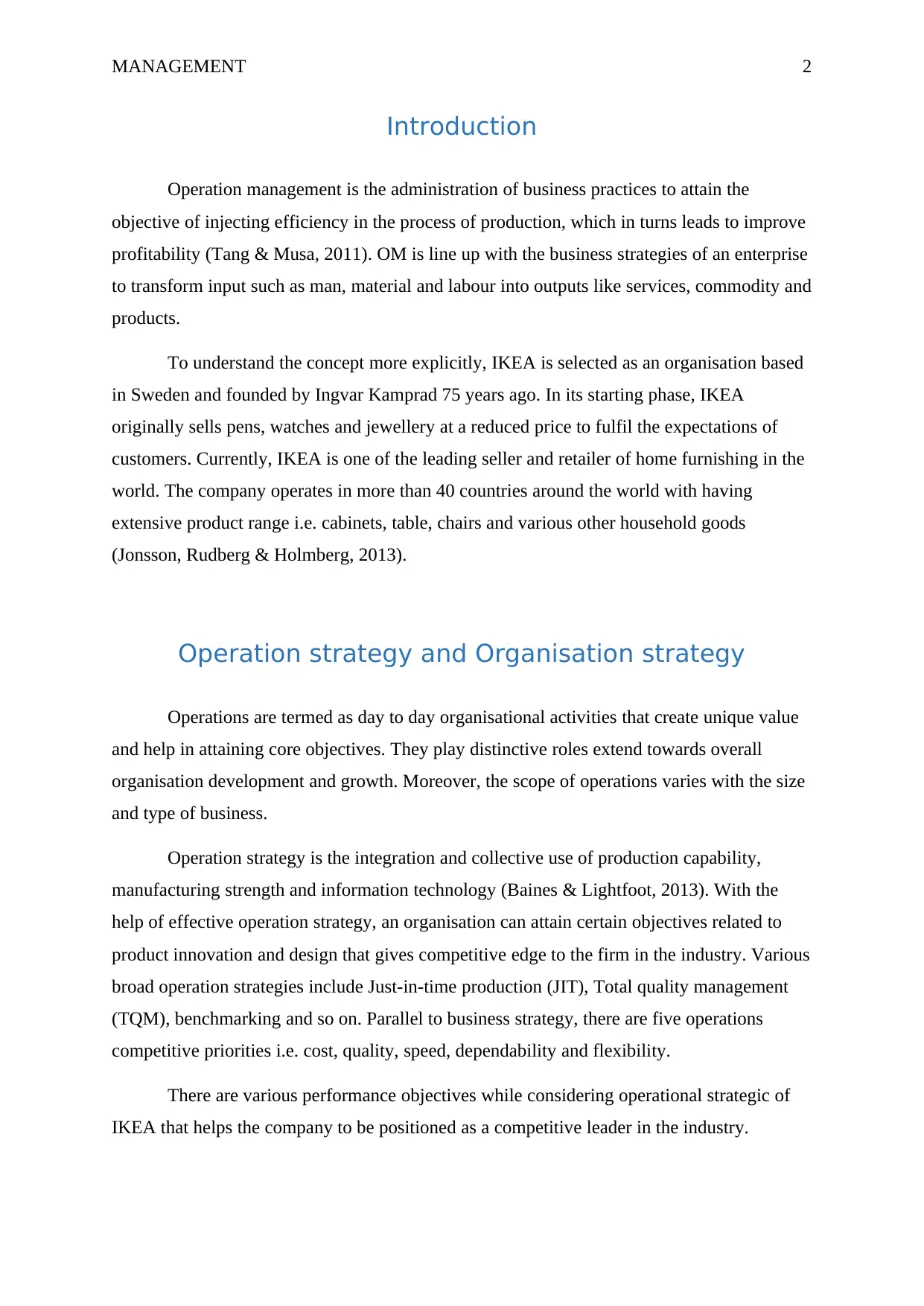
MANAGEMENT 2
Introduction
Operation management is the administration of business practices to attain the
objective of injecting efficiency in the process of production, which in turns leads to improve
profitability (Tang & Musa, 2011). OM is line up with the business strategies of an enterprise
to transform input such as man, material and labour into outputs like services, commodity and
products.
To understand the concept more explicitly, IKEA is selected as an organisation based
in Sweden and founded by Ingvar Kamprad 75 years ago. In its starting phase, IKEA
originally sells pens, watches and jewellery at a reduced price to fulfil the expectations of
customers. Currently, IKEA is one of the leading seller and retailer of home furnishing in the
world. The company operates in more than 40 countries around the world with having
extensive product range i.e. cabinets, table, chairs and various other household goods
(Jonsson, Rudberg & Holmberg, 2013).
Operation strategy and Organisation strategy
Operations are termed as day to day organisational activities that create unique value
and help in attaining core objectives. They play distinctive roles extend towards overall
organisation development and growth. Moreover, the scope of operations varies with the size
and type of business.
Operation strategy is the integration and collective use of production capability,
manufacturing strength and information technology (Baines & Lightfoot, 2013). With the
help of effective operation strategy, an organisation can attain certain objectives related to
product innovation and design that gives competitive edge to the firm in the industry. Various
broad operation strategies include Just-in-time production (JIT), Total quality management
(TQM), benchmarking and so on. Parallel to business strategy, there are five operations
competitive priorities i.e. cost, quality, speed, dependability and flexibility.
There are various performance objectives while considering operational strategic of
IKEA that helps the company to be positioned as a competitive leader in the industry.
Introduction
Operation management is the administration of business practices to attain the
objective of injecting efficiency in the process of production, which in turns leads to improve
profitability (Tang & Musa, 2011). OM is line up with the business strategies of an enterprise
to transform input such as man, material and labour into outputs like services, commodity and
products.
To understand the concept more explicitly, IKEA is selected as an organisation based
in Sweden and founded by Ingvar Kamprad 75 years ago. In its starting phase, IKEA
originally sells pens, watches and jewellery at a reduced price to fulfil the expectations of
customers. Currently, IKEA is one of the leading seller and retailer of home furnishing in the
world. The company operates in more than 40 countries around the world with having
extensive product range i.e. cabinets, table, chairs and various other household goods
(Jonsson, Rudberg & Holmberg, 2013).
Operation strategy and Organisation strategy
Operations are termed as day to day organisational activities that create unique value
and help in attaining core objectives. They play distinctive roles extend towards overall
organisation development and growth. Moreover, the scope of operations varies with the size
and type of business.
Operation strategy is the integration and collective use of production capability,
manufacturing strength and information technology (Baines & Lightfoot, 2013). With the
help of effective operation strategy, an organisation can attain certain objectives related to
product innovation and design that gives competitive edge to the firm in the industry. Various
broad operation strategies include Just-in-time production (JIT), Total quality management
(TQM), benchmarking and so on. Parallel to business strategy, there are five operations
competitive priorities i.e. cost, quality, speed, dependability and flexibility.
There are various performance objectives while considering operational strategic of
IKEA that helps the company to be positioned as a competitive leader in the industry.
⊘ This is a preview!⊘
Do you want full access?
Subscribe today to unlock all pages.

Trusted by 1+ million students worldwide
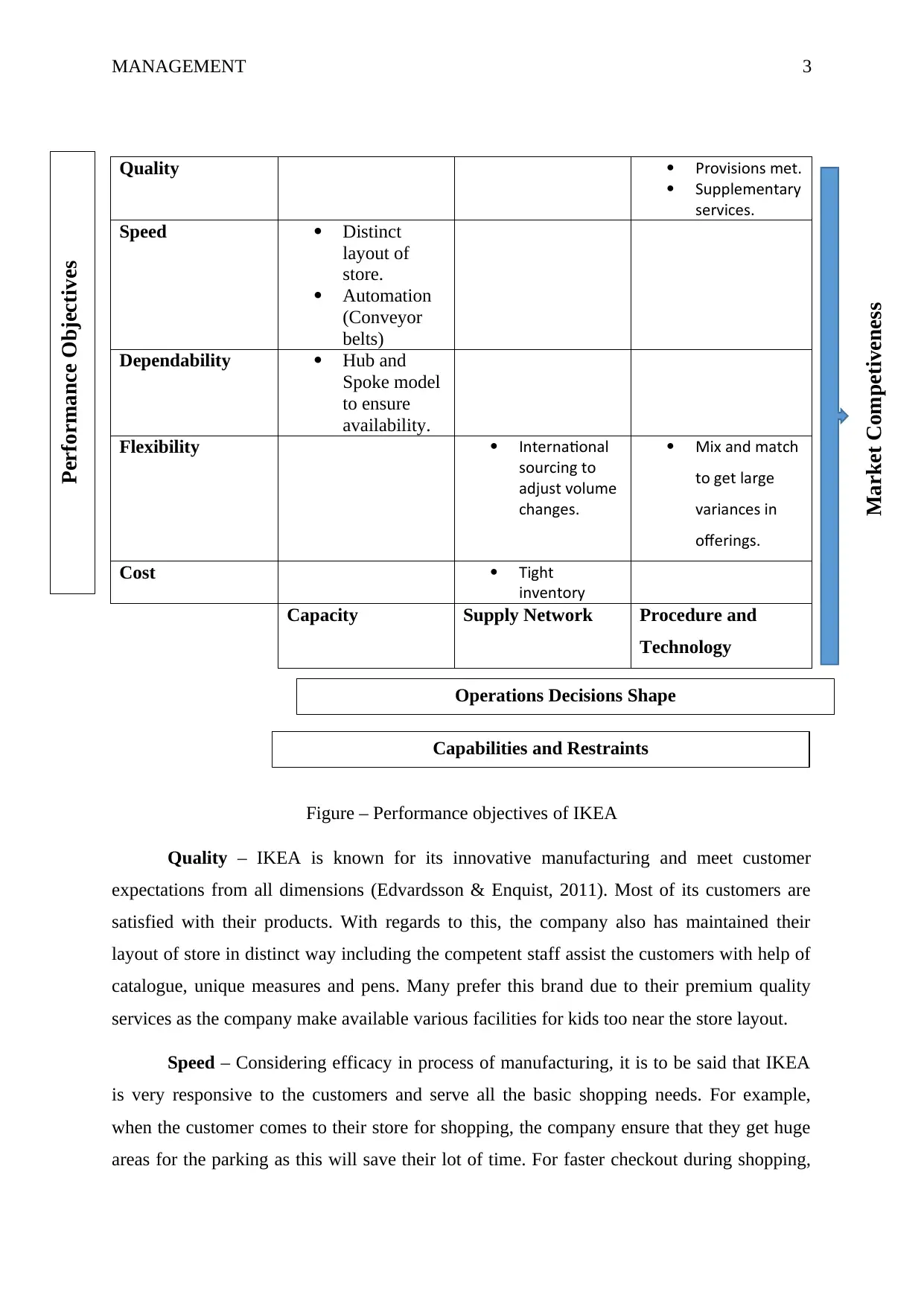
MANAGEMENT 3
Quality Provisions met.
Supplementary
services.
Speed Distinct
layout of
store.
Automation
(Conveyor
belts)
Dependability Hub and
Spoke model
to ensure
availability.
Flexibility International
sourcing to
adjust volume
changes.
Mix and match
to get large
variances in
offerings.
Cost Tight
inventory
Capacity Supply Network Procedure and
Technology
Figure – Performance objectives of IKEA
Quality – IKEA is known for its innovative manufacturing and meet customer
expectations from all dimensions (Edvardsson & Enquist, 2011). Most of its customers are
satisfied with their products. With regards to this, the company also has maintained their
layout of store in distinct way including the competent staff assist the customers with help of
catalogue, unique measures and pens. Many prefer this brand due to their premium quality
services as the company make available various facilities for kids too near the store layout.
Speed – Considering efficacy in process of manufacturing, it is to be said that IKEA
is very responsive to the customers and serve all the basic shopping needs. For example,
when the customer comes to their store for shopping, the company ensure that they get huge
areas for the parking as this will save their lot of time. For faster checkout during shopping,
Performance Objectives
Operations Decisions Shape
Capabilities and Restraints
Market Competiveness
Quality Provisions met.
Supplementary
services.
Speed Distinct
layout of
store.
Automation
(Conveyor
belts)
Dependability Hub and
Spoke model
to ensure
availability.
Flexibility International
sourcing to
adjust volume
changes.
Mix and match
to get large
variances in
offerings.
Cost Tight
inventory
Capacity Supply Network Procedure and
Technology
Figure – Performance objectives of IKEA
Quality – IKEA is known for its innovative manufacturing and meet customer
expectations from all dimensions (Edvardsson & Enquist, 2011). Most of its customers are
satisfied with their products. With regards to this, the company also has maintained their
layout of store in distinct way including the competent staff assist the customers with help of
catalogue, unique measures and pens. Many prefer this brand due to their premium quality
services as the company make available various facilities for kids too near the store layout.
Speed – Considering efficacy in process of manufacturing, it is to be said that IKEA
is very responsive to the customers and serve all the basic shopping needs. For example,
when the customer comes to their store for shopping, the company ensure that they get huge
areas for the parking as this will save their lot of time. For faster checkout during shopping,
Performance Objectives
Operations Decisions Shape
Capabilities and Restraints
Market Competiveness
Paraphrase This Document
Need a fresh take? Get an instant paraphrase of this document with our AI Paraphraser
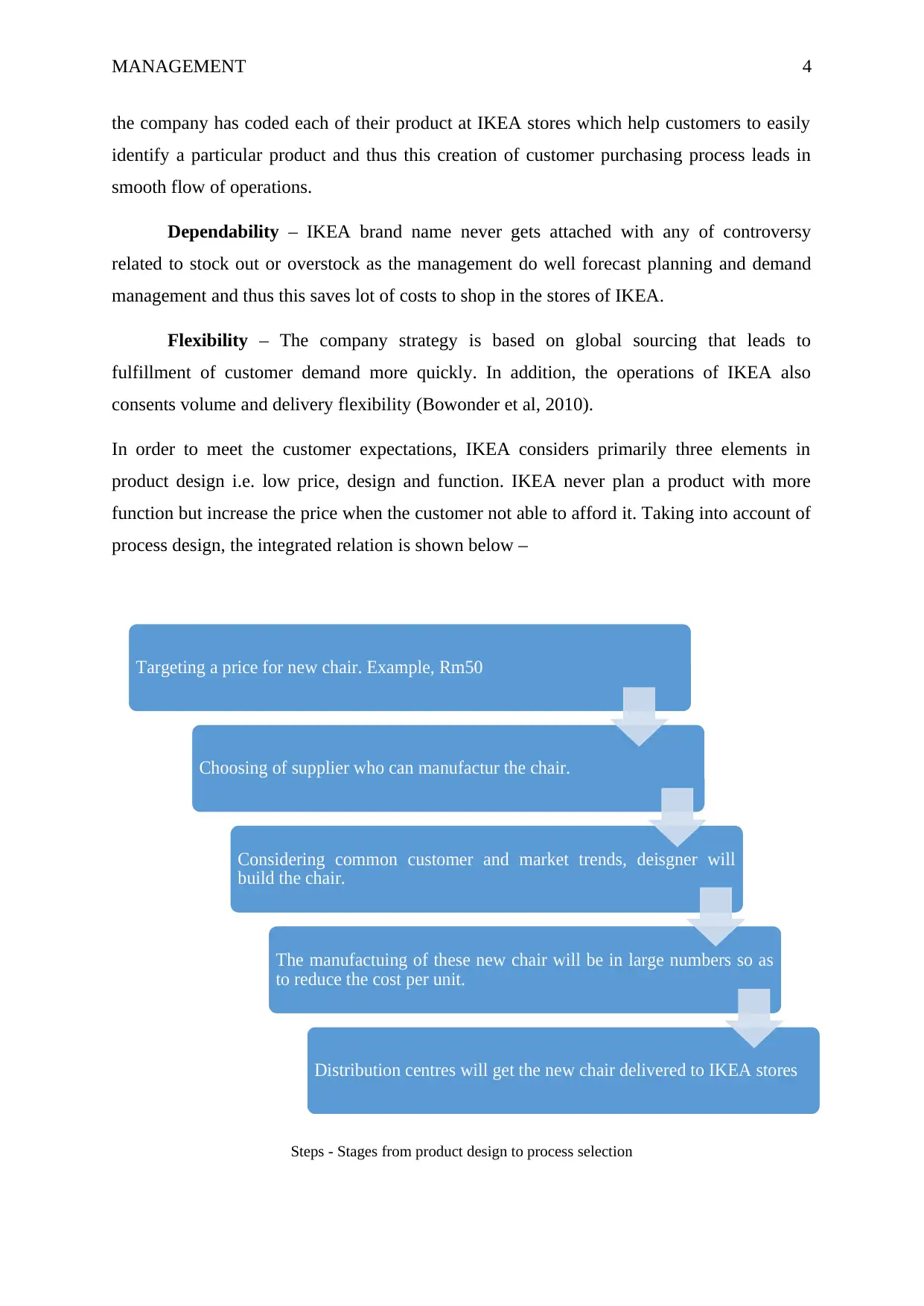
MANAGEMENT 4
the company has coded each of their product at IKEA stores which help customers to easily
identify a particular product and thus this creation of customer purchasing process leads in
smooth flow of operations.
Dependability – IKEA brand name never gets attached with any of controversy
related to stock out or overstock as the management do well forecast planning and demand
management and thus this saves lot of costs to shop in the stores of IKEA.
Flexibility – The company strategy is based on global sourcing that leads to
fulfillment of customer demand more quickly. In addition, the operations of IKEA also
consents volume and delivery flexibility (Bowonder et al, 2010).
In order to meet the customer expectations, IKEA considers primarily three elements in
product design i.e. low price, design and function. IKEA never plan a product with more
function but increase the price when the customer not able to afford it. Taking into account of
process design, the integrated relation is shown below –
Steps - Stages from product design to process selection
Targeting a price for new chair. Example, Rm50
Choosing of supplier who can manufactur the chair.
Considering common customer and market trends, deisgner will
build the chair.
The manufactuing of these new chair will be in large numbers so as
to reduce the cost per unit.
Distribution centres will get the new chair delivered to IKEA stores
the company has coded each of their product at IKEA stores which help customers to easily
identify a particular product and thus this creation of customer purchasing process leads in
smooth flow of operations.
Dependability – IKEA brand name never gets attached with any of controversy
related to stock out or overstock as the management do well forecast planning and demand
management and thus this saves lot of costs to shop in the stores of IKEA.
Flexibility – The company strategy is based on global sourcing that leads to
fulfillment of customer demand more quickly. In addition, the operations of IKEA also
consents volume and delivery flexibility (Bowonder et al, 2010).
In order to meet the customer expectations, IKEA considers primarily three elements in
product design i.e. low price, design and function. IKEA never plan a product with more
function but increase the price when the customer not able to afford it. Taking into account of
process design, the integrated relation is shown below –
Steps - Stages from product design to process selection
Targeting a price for new chair. Example, Rm50
Choosing of supplier who can manufactur the chair.
Considering common customer and market trends, deisgner will
build the chair.
The manufactuing of these new chair will be in large numbers so as
to reduce the cost per unit.
Distribution centres will get the new chair delivered to IKEA stores
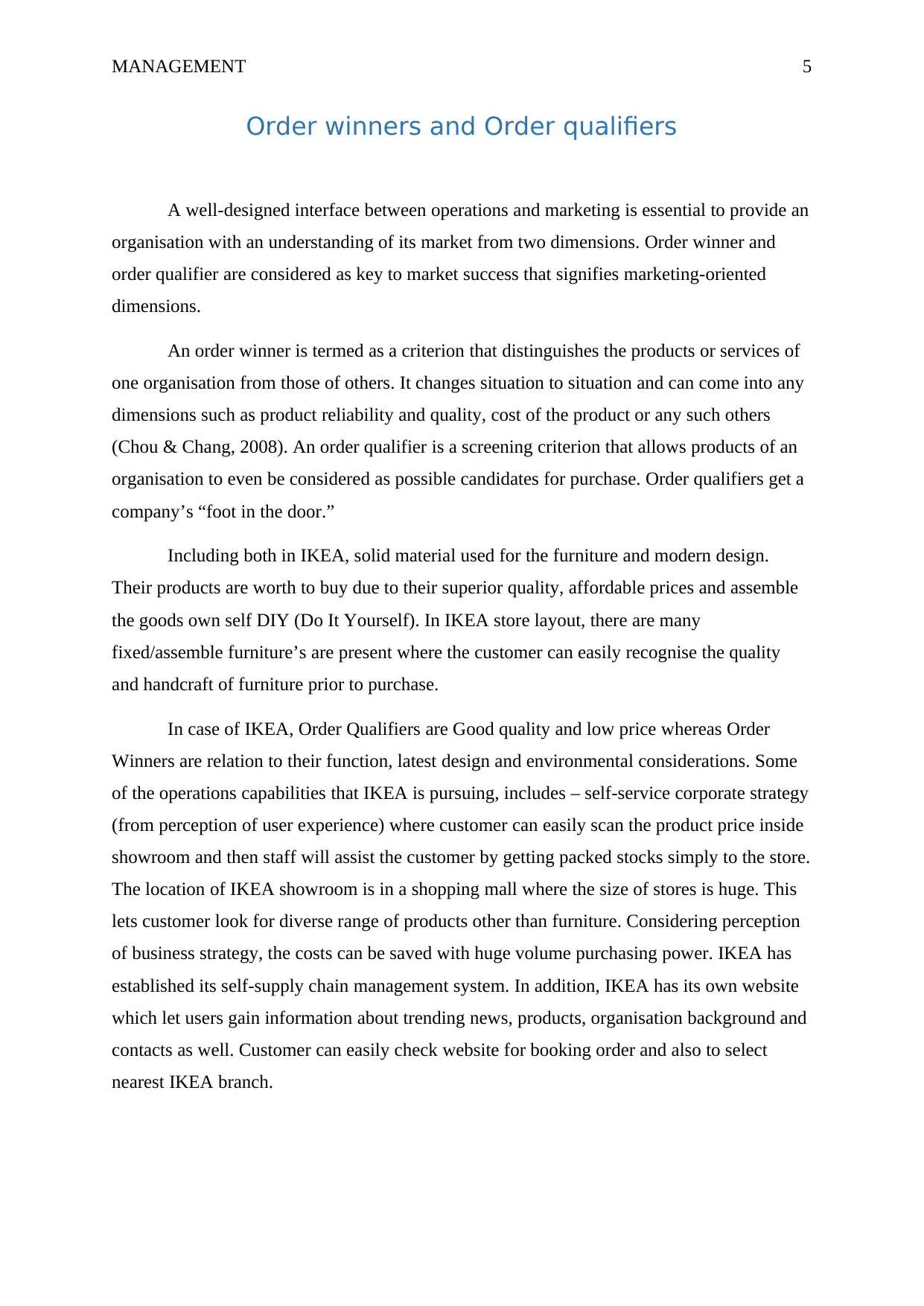
MANAGEMENT 5
Order winners and Order qualifiers
A well-designed interface between operations and marketing is essential to provide an
organisation with an understanding of its market from two dimensions. Order winner and
order qualifier are considered as key to market success that signifies marketing-oriented
dimensions.
An order winner is termed as a criterion that distinguishes the products or services of
one organisation from those of others. It changes situation to situation and can come into any
dimensions such as product reliability and quality, cost of the product or any such others
(Chou & Chang, 2008). An order qualifier is a screening criterion that allows products of an
organisation to even be considered as possible candidates for purchase. Order qualifiers get a
company’s “foot in the door.”
Including both in IKEA, solid material used for the furniture and modern design.
Their products are worth to buy due to their superior quality, affordable prices and assemble
the goods own self DIY (Do It Yourself). In IKEA store layout, there are many
fixed/assemble furniture’s are present where the customer can easily recognise the quality
and handcraft of furniture prior to purchase.
In case of IKEA, Order Qualifiers are Good quality and low price whereas Order
Winners are relation to their function, latest design and environmental considerations. Some
of the operations capabilities that IKEA is pursuing, includes – self-service corporate strategy
(from perception of user experience) where customer can easily scan the product price inside
showroom and then staff will assist the customer by getting packed stocks simply to the store.
The location of IKEA showroom is in a shopping mall where the size of stores is huge. This
lets customer look for diverse range of products other than furniture. Considering perception
of business strategy, the costs can be saved with huge volume purchasing power. IKEA has
established its self-supply chain management system. In addition, IKEA has its own website
which let users gain information about trending news, products, organisation background and
contacts as well. Customer can easily check website for booking order and also to select
nearest IKEA branch.
Order winners and Order qualifiers
A well-designed interface between operations and marketing is essential to provide an
organisation with an understanding of its market from two dimensions. Order winner and
order qualifier are considered as key to market success that signifies marketing-oriented
dimensions.
An order winner is termed as a criterion that distinguishes the products or services of
one organisation from those of others. It changes situation to situation and can come into any
dimensions such as product reliability and quality, cost of the product or any such others
(Chou & Chang, 2008). An order qualifier is a screening criterion that allows products of an
organisation to even be considered as possible candidates for purchase. Order qualifiers get a
company’s “foot in the door.”
Including both in IKEA, solid material used for the furniture and modern design.
Their products are worth to buy due to their superior quality, affordable prices and assemble
the goods own self DIY (Do It Yourself). In IKEA store layout, there are many
fixed/assemble furniture’s are present where the customer can easily recognise the quality
and handcraft of furniture prior to purchase.
In case of IKEA, Order Qualifiers are Good quality and low price whereas Order
Winners are relation to their function, latest design and environmental considerations. Some
of the operations capabilities that IKEA is pursuing, includes – self-service corporate strategy
(from perception of user experience) where customer can easily scan the product price inside
showroom and then staff will assist the customer by getting packed stocks simply to the store.
The location of IKEA showroom is in a shopping mall where the size of stores is huge. This
lets customer look for diverse range of products other than furniture. Considering perception
of business strategy, the costs can be saved with huge volume purchasing power. IKEA has
established its self-supply chain management system. In addition, IKEA has its own website
which let users gain information about trending news, products, organisation background and
contacts as well. Customer can easily check website for booking order and also to select
nearest IKEA branch.
⊘ This is a preview!⊘
Do you want full access?
Subscribe today to unlock all pages.

Trusted by 1+ million students worldwide
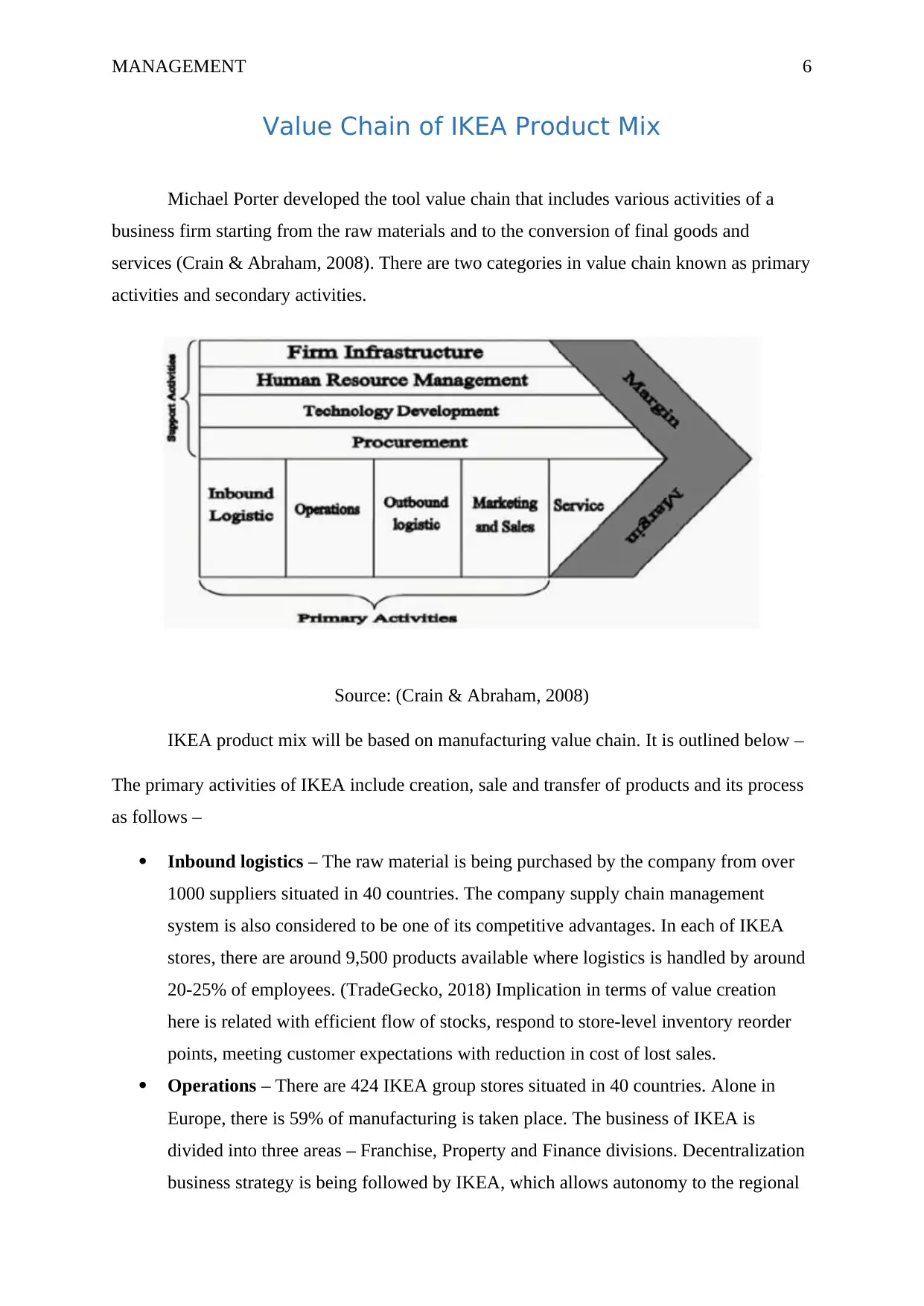
MANAGEMENT 6
Value Chain of IKEA Product Mix
Michael Porter developed the tool value chain that includes various activities of a
business firm starting from the raw materials and to the conversion of final goods and
services (Crain & Abraham, 2008). There are two categories in value chain known as primary
activities and secondary activities.
Source: (Crain & Abraham, 2008)
IKEA product mix will be based on manufacturing value chain. It is outlined below –
The primary activities of IKEA include creation, sale and transfer of products and its process
as follows –
Inbound logistics – The raw material is being purchased by the company from over
1000 suppliers situated in 40 countries. The company supply chain management
system is also considered to be one of its competitive advantages. In each of IKEA
stores, there are around 9,500 products available where logistics is handled by around
20-25% of employees. (TradeGecko, 2018) Implication in terms of value creation
here is related with efficient flow of stocks, respond to store-level inventory reorder
points, meeting customer expectations with reduction in cost of lost sales.
Operations – There are 424 IKEA group stores situated in 40 countries. Alone in
Europe, there is 59% of manufacturing is taken place. The business of IKEA is
divided into three areas – Franchise, Property and Finance divisions. Decentralization
business strategy is being followed by IKEA, which allows autonomy to the regional
Value Chain of IKEA Product Mix
Michael Porter developed the tool value chain that includes various activities of a
business firm starting from the raw materials and to the conversion of final goods and
services (Crain & Abraham, 2008). There are two categories in value chain known as primary
activities and secondary activities.
Source: (Crain & Abraham, 2008)
IKEA product mix will be based on manufacturing value chain. It is outlined below –
The primary activities of IKEA include creation, sale and transfer of products and its process
as follows –
Inbound logistics – The raw material is being purchased by the company from over
1000 suppliers situated in 40 countries. The company supply chain management
system is also considered to be one of its competitive advantages. In each of IKEA
stores, there are around 9,500 products available where logistics is handled by around
20-25% of employees. (TradeGecko, 2018) Implication in terms of value creation
here is related with efficient flow of stocks, respond to store-level inventory reorder
points, meeting customer expectations with reduction in cost of lost sales.
Operations – There are 424 IKEA group stores situated in 40 countries. Alone in
Europe, there is 59% of manufacturing is taken place. The business of IKEA is
divided into three areas – Franchise, Property and Finance divisions. Decentralization
business strategy is being followed by IKEA, which allows autonomy to the regional
Paraphrase This Document
Need a fresh take? Get an instant paraphrase of this document with our AI Paraphraser
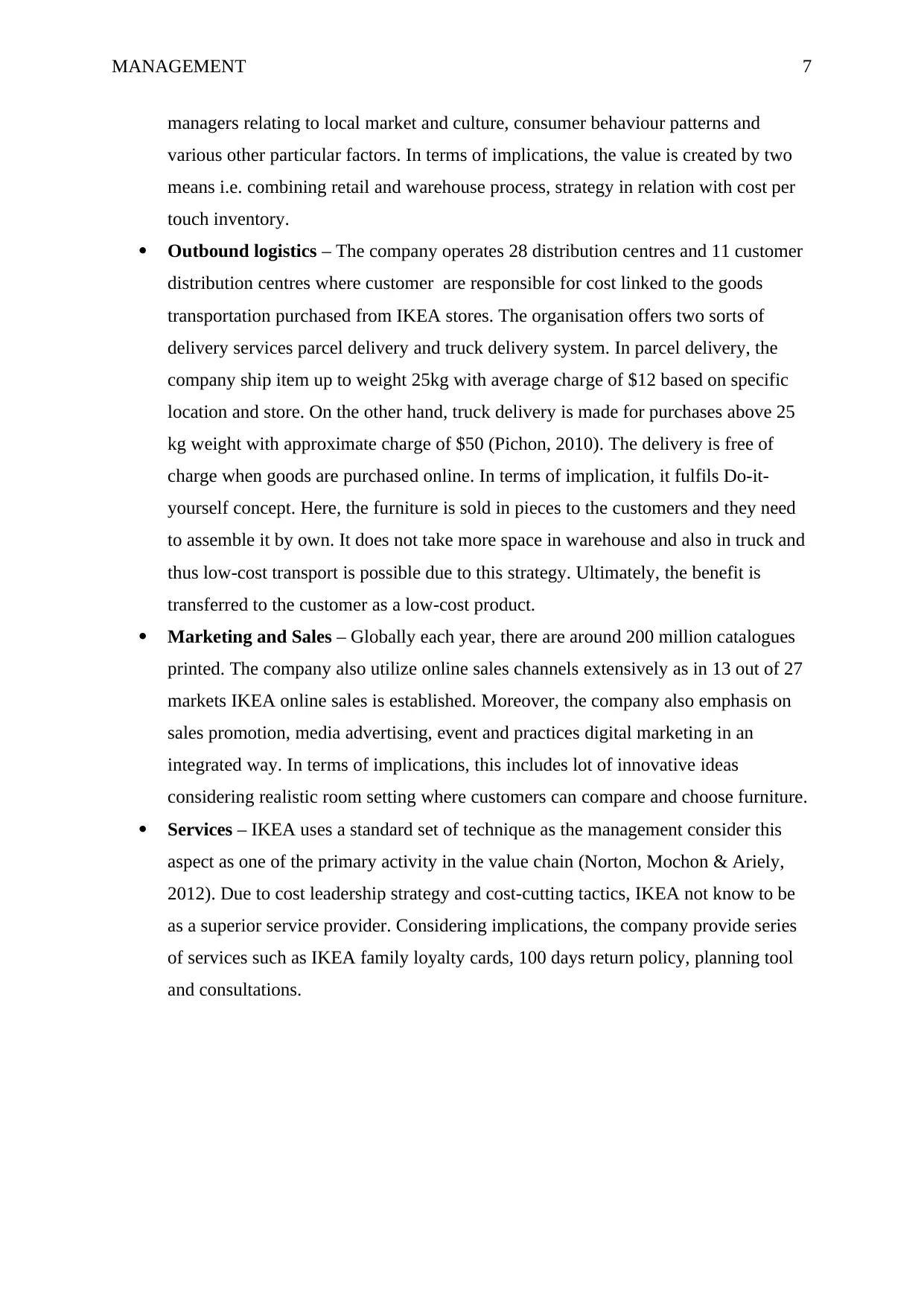
MANAGEMENT 7
managers relating to local market and culture, consumer behaviour patterns and
various other particular factors. In terms of implications, the value is created by two
means i.e. combining retail and warehouse process, strategy in relation with cost per
touch inventory.
Outbound logistics – The company operates 28 distribution centres and 11 customer
distribution centres where customer are responsible for cost linked to the goods
transportation purchased from IKEA stores. The organisation offers two sorts of
delivery services parcel delivery and truck delivery system. In parcel delivery, the
company ship item up to weight 25kg with average charge of $12 based on specific
location and store. On the other hand, truck delivery is made for purchases above 25
kg weight with approximate charge of $50 (Pichon, 2010). The delivery is free of
charge when goods are purchased online. In terms of implication, it fulfils Do-it-
yourself concept. Here, the furniture is sold in pieces to the customers and they need
to assemble it by own. It does not take more space in warehouse and also in truck and
thus low-cost transport is possible due to this strategy. Ultimately, the benefit is
transferred to the customer as a low-cost product.
Marketing and Sales – Globally each year, there are around 200 million catalogues
printed. The company also utilize online sales channels extensively as in 13 out of 27
markets IKEA online sales is established. Moreover, the company also emphasis on
sales promotion, media advertising, event and practices digital marketing in an
integrated way. In terms of implications, this includes lot of innovative ideas
considering realistic room setting where customers can compare and choose furniture.
Services – IKEA uses a standard set of technique as the management consider this
aspect as one of the primary activity in the value chain (Norton, Mochon & Ariely,
2012). Due to cost leadership strategy and cost-cutting tactics, IKEA not know to be
as a superior service provider. Considering implications, the company provide series
of services such as IKEA family loyalty cards, 100 days return policy, planning tool
and consultations.
managers relating to local market and culture, consumer behaviour patterns and
various other particular factors. In terms of implications, the value is created by two
means i.e. combining retail and warehouse process, strategy in relation with cost per
touch inventory.
Outbound logistics – The company operates 28 distribution centres and 11 customer
distribution centres where customer are responsible for cost linked to the goods
transportation purchased from IKEA stores. The organisation offers two sorts of
delivery services parcel delivery and truck delivery system. In parcel delivery, the
company ship item up to weight 25kg with average charge of $12 based on specific
location and store. On the other hand, truck delivery is made for purchases above 25
kg weight with approximate charge of $50 (Pichon, 2010). The delivery is free of
charge when goods are purchased online. In terms of implication, it fulfils Do-it-
yourself concept. Here, the furniture is sold in pieces to the customers and they need
to assemble it by own. It does not take more space in warehouse and also in truck and
thus low-cost transport is possible due to this strategy. Ultimately, the benefit is
transferred to the customer as a low-cost product.
Marketing and Sales – Globally each year, there are around 200 million catalogues
printed. The company also utilize online sales channels extensively as in 13 out of 27
markets IKEA online sales is established. Moreover, the company also emphasis on
sales promotion, media advertising, event and practices digital marketing in an
integrated way. In terms of implications, this includes lot of innovative ideas
considering realistic room setting where customers can compare and choose furniture.
Services – IKEA uses a standard set of technique as the management consider this
aspect as one of the primary activity in the value chain (Norton, Mochon & Ariely,
2012). Due to cost leadership strategy and cost-cutting tactics, IKEA not know to be
as a superior service provider. Considering implications, the company provide series
of services such as IKEA family loyalty cards, 100 days return policy, planning tool
and consultations.
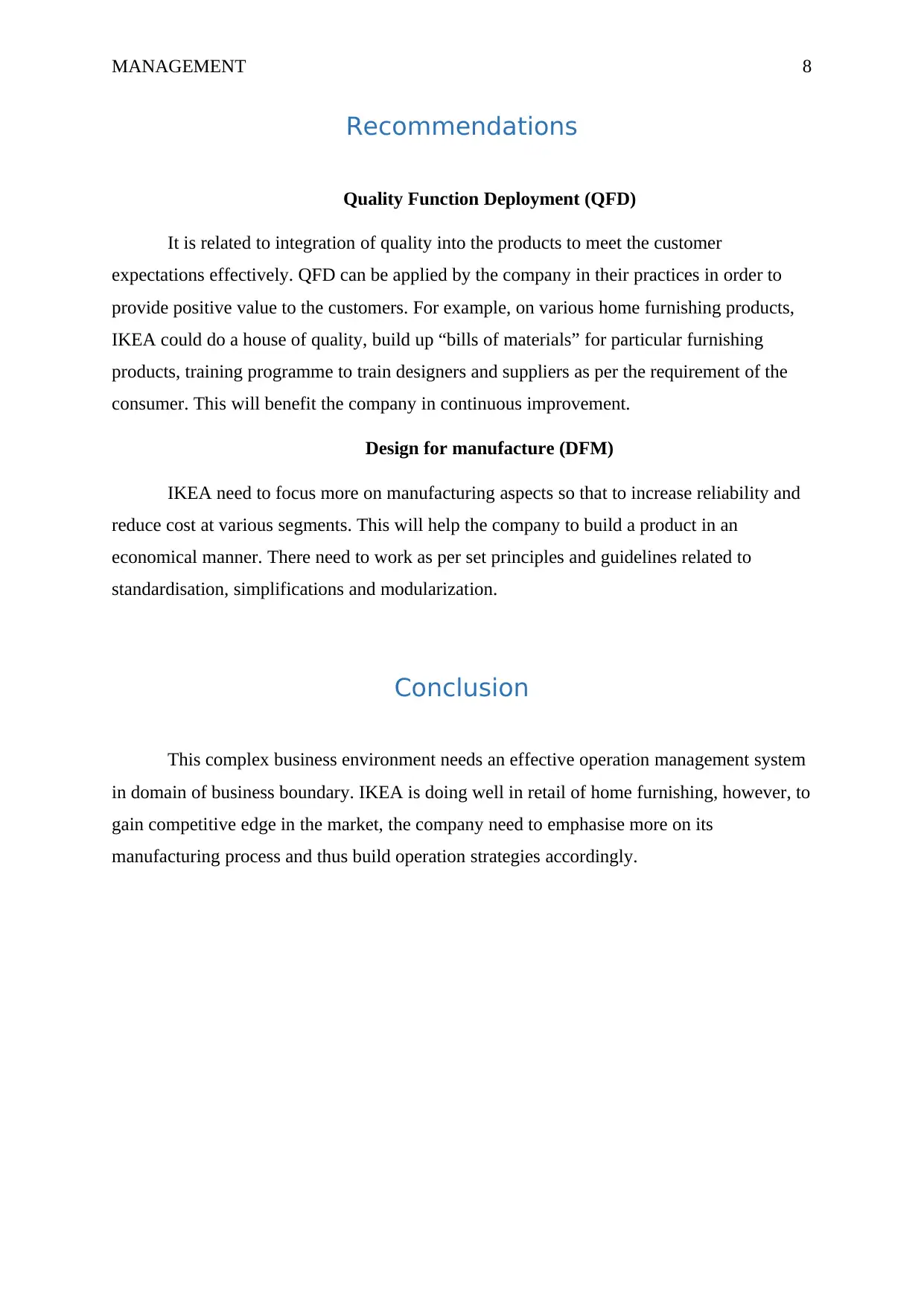
MANAGEMENT 8
Recommendations
Quality Function Deployment (QFD)
It is related to integration of quality into the products to meet the customer
expectations effectively. QFD can be applied by the company in their practices in order to
provide positive value to the customers. For example, on various home furnishing products,
IKEA could do a house of quality, build up “bills of materials” for particular furnishing
products, training programme to train designers and suppliers as per the requirement of the
consumer. This will benefit the company in continuous improvement.
Design for manufacture (DFM)
IKEA need to focus more on manufacturing aspects so that to increase reliability and
reduce cost at various segments. This will help the company to build a product in an
economical manner. There need to work as per set principles and guidelines related to
standardisation, simplifications and modularization.
Conclusion
This complex business environment needs an effective operation management system
in domain of business boundary. IKEA is doing well in retail of home furnishing, however, to
gain competitive edge in the market, the company need to emphasise more on its
manufacturing process and thus build operation strategies accordingly.
Recommendations
Quality Function Deployment (QFD)
It is related to integration of quality into the products to meet the customer
expectations effectively. QFD can be applied by the company in their practices in order to
provide positive value to the customers. For example, on various home furnishing products,
IKEA could do a house of quality, build up “bills of materials” for particular furnishing
products, training programme to train designers and suppliers as per the requirement of the
consumer. This will benefit the company in continuous improvement.
Design for manufacture (DFM)
IKEA need to focus more on manufacturing aspects so that to increase reliability and
reduce cost at various segments. This will help the company to build a product in an
economical manner. There need to work as per set principles and guidelines related to
standardisation, simplifications and modularization.
Conclusion
This complex business environment needs an effective operation management system
in domain of business boundary. IKEA is doing well in retail of home furnishing, however, to
gain competitive edge in the market, the company need to emphasise more on its
manufacturing process and thus build operation strategies accordingly.
⊘ This is a preview!⊘
Do you want full access?
Subscribe today to unlock all pages.

Trusted by 1+ million students worldwide
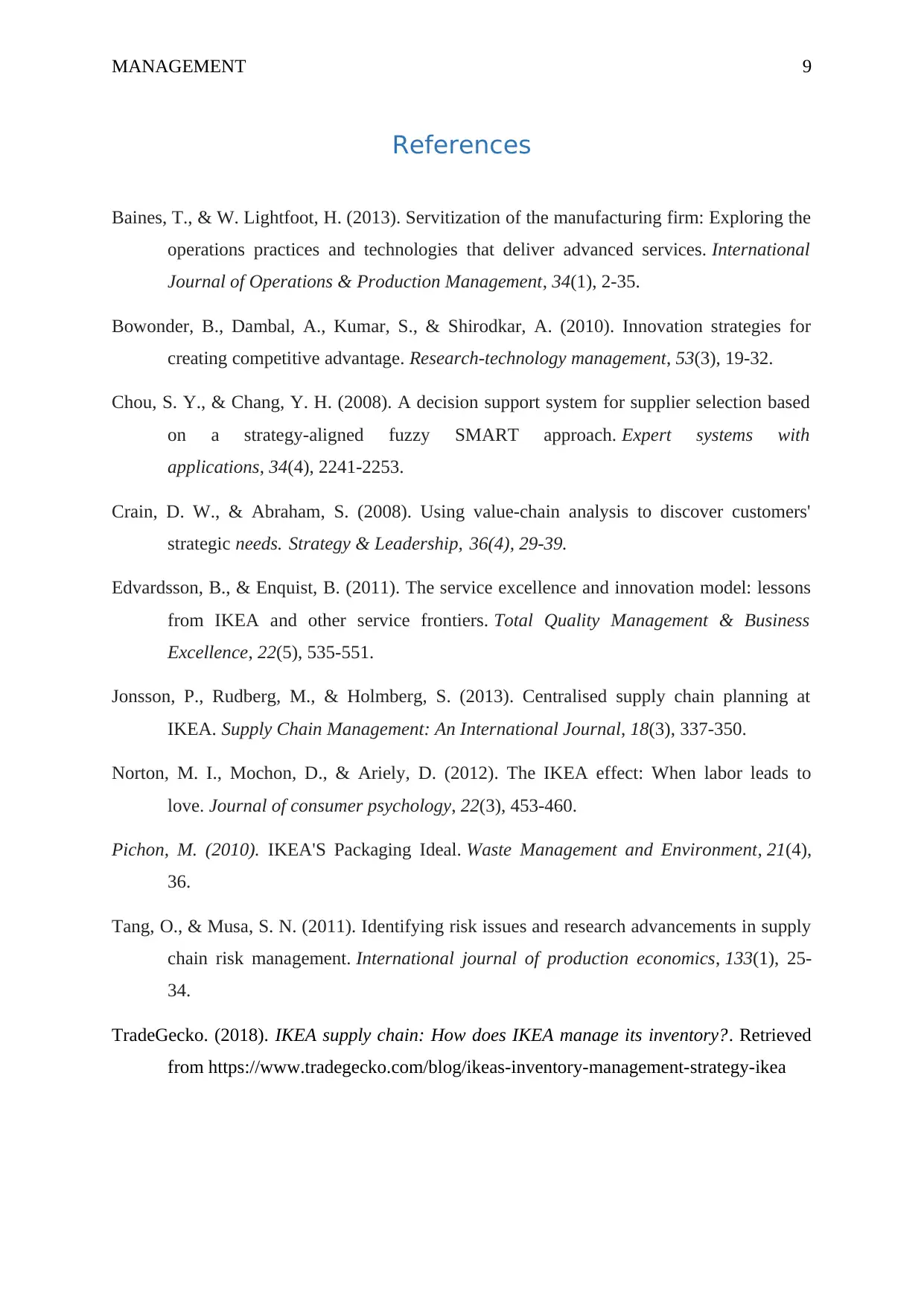
MANAGEMENT 9
References
Baines, T., & W. Lightfoot, H. (2013). Servitization of the manufacturing firm: Exploring the
operations practices and technologies that deliver advanced services. International
Journal of Operations & Production Management, 34(1), 2-35.
Bowonder, B., Dambal, A., Kumar, S., & Shirodkar, A. (2010). Innovation strategies for
creating competitive advantage. Research-technology management, 53(3), 19-32.
Chou, S. Y., & Chang, Y. H. (2008). A decision support system for supplier selection based
on a strategy-aligned fuzzy SMART approach. Expert systems with
applications, 34(4), 2241-2253.
Crain, D. W., & Abraham, S. (2008). Using value-chain analysis to discover customers'
strategic needs. Strategy & Leadership, 36(4), 29-39.
Edvardsson, B., & Enquist, B. (2011). The service excellence and innovation model: lessons
from IKEA and other service frontiers. Total Quality Management & Business
Excellence, 22(5), 535-551.
Jonsson, P., Rudberg, M., & Holmberg, S. (2013). Centralised supply chain planning at
IKEA. Supply Chain Management: An International Journal, 18(3), 337-350.
Norton, M. I., Mochon, D., & Ariely, D. (2012). The IKEA effect: When labor leads to
love. Journal of consumer psychology, 22(3), 453-460.
Pichon, M. (2010). IKEA'S Packaging Ideal. Waste Management and Environment, 21(4),
36.
Tang, O., & Musa, S. N. (2011). Identifying risk issues and research advancements in supply
chain risk management. International journal of production economics, 133(1), 25-
34.
TradeGecko. (2018). IKEA supply chain: How does IKEA manage its inventory?. Retrieved
from https://www.tradegecko.com/blog/ikeas-inventory-management-strategy-ikea
References
Baines, T., & W. Lightfoot, H. (2013). Servitization of the manufacturing firm: Exploring the
operations practices and technologies that deliver advanced services. International
Journal of Operations & Production Management, 34(1), 2-35.
Bowonder, B., Dambal, A., Kumar, S., & Shirodkar, A. (2010). Innovation strategies for
creating competitive advantage. Research-technology management, 53(3), 19-32.
Chou, S. Y., & Chang, Y. H. (2008). A decision support system for supplier selection based
on a strategy-aligned fuzzy SMART approach. Expert systems with
applications, 34(4), 2241-2253.
Crain, D. W., & Abraham, S. (2008). Using value-chain analysis to discover customers'
strategic needs. Strategy & Leadership, 36(4), 29-39.
Edvardsson, B., & Enquist, B. (2011). The service excellence and innovation model: lessons
from IKEA and other service frontiers. Total Quality Management & Business
Excellence, 22(5), 535-551.
Jonsson, P., Rudberg, M., & Holmberg, S. (2013). Centralised supply chain planning at
IKEA. Supply Chain Management: An International Journal, 18(3), 337-350.
Norton, M. I., Mochon, D., & Ariely, D. (2012). The IKEA effect: When labor leads to
love. Journal of consumer psychology, 22(3), 453-460.
Pichon, M. (2010). IKEA'S Packaging Ideal. Waste Management and Environment, 21(4),
36.
Tang, O., & Musa, S. N. (2011). Identifying risk issues and research advancements in supply
chain risk management. International journal of production economics, 133(1), 25-
34.
TradeGecko. (2018). IKEA supply chain: How does IKEA manage its inventory?. Retrieved
from https://www.tradegecko.com/blog/ikeas-inventory-management-strategy-ikea
1 out of 10
Related Documents
Your All-in-One AI-Powered Toolkit for Academic Success.
+13062052269
info@desklib.com
Available 24*7 on WhatsApp / Email
![[object Object]](/_next/static/media/star-bottom.7253800d.svg)
Unlock your academic potential
Copyright © 2020–2025 A2Z Services. All Rights Reserved. Developed and managed by ZUCOL.




